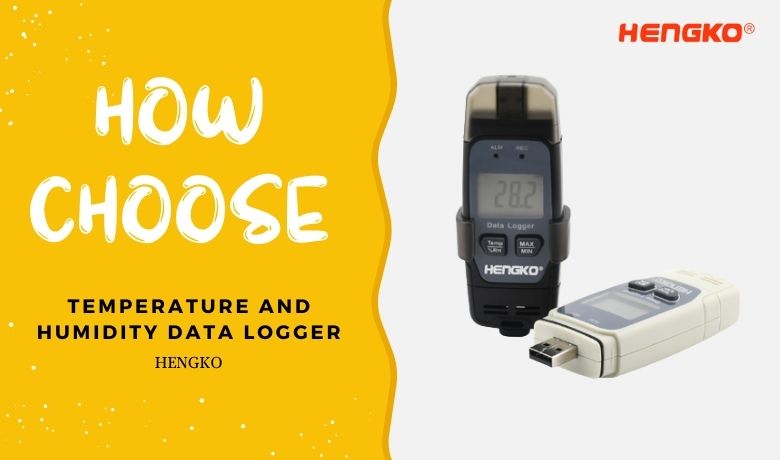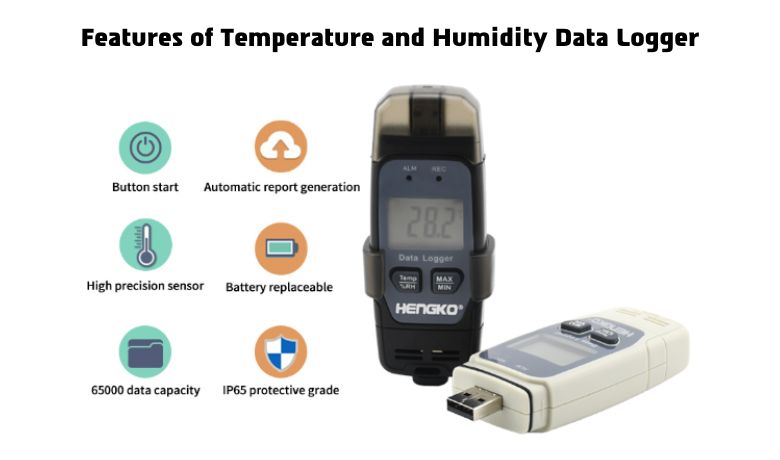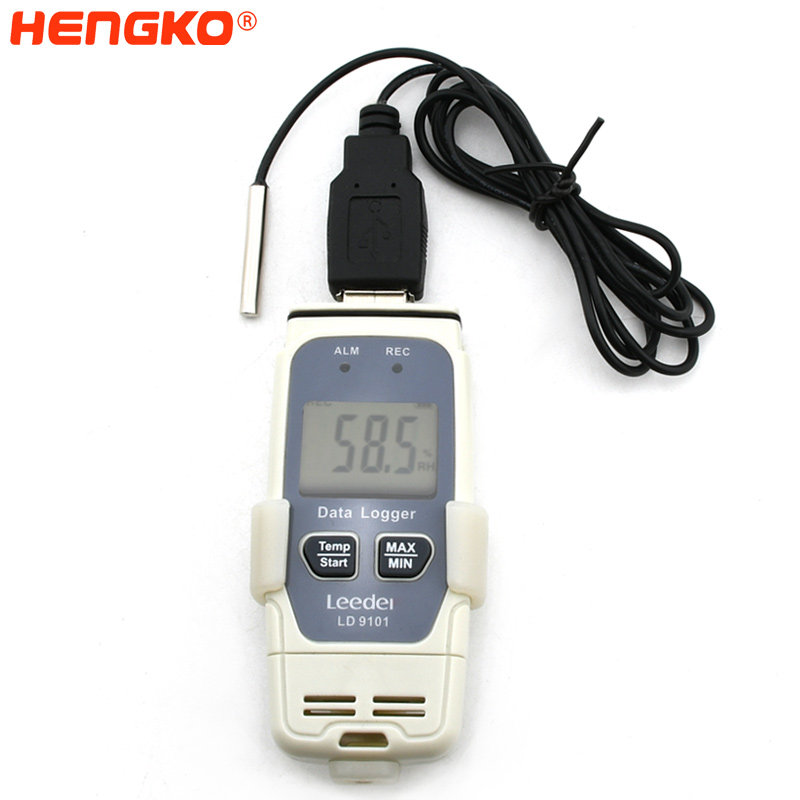
Temperature and humidity data logger is widely used in all walks of life in the world, such as agricultural scientific research, food safety, pharmaceutical storage, chemical industry, environmental protection and other industries. Temperature and humidity recorder is mainly used for monitoring and recording temperature and humidity of food, medicine and fresh goods in the process of storage and transportation.
What is the Temperature and Humidity Data Logger?
Temperature and humidity data logger is a temperature and humidity measuring instrument. Built-in temperature and humidity sensor or external temperature and humidity sensor probe. The recorder is mainly used to record the temperature and humidity data of refrigeration, vaccines, food and fresh food during storage and transportation, and save the data records in the equipment. Usually, temperature data loggers also have a PC data upload function that can be used for data viewing and analysis. HENGKO PDF temperature and humidity recorder can perform curve analysis through the data platform and save the output data as a PDF file.
Main Features of Temperature And Humidity Data Logger
A temperature and humidity data logger is a device that is used to monitor and record temperature and humidity levels over a specific period of time. Here are some of the main features of a temperature and humidity data logger:
-
Accuracy: The device has high accuracy in measuring both temperature and humidity. This ensures reliable and precise data.
-
Storage Capacity: These devices typically have a large storage capacity to log and store data over an extended period. This could range from thousands to even millions of readings.
-
Long Battery Life: They are usually equipped with long-lasting batteries to ensure continuous data recording, which is especially useful in long-term monitoring situations.
-
Data Transfer Options: Most models come with USB ports for easy data transfer to computers for further analysis. Some advanced models may offer wireless connectivity such as Wi-Fi or Bluetooth to transfer data, making the process even more convenient.
-
Software Compatibility: These devices often come with compatible software that allows for easy data analysis and report generation.
-
Real-Time Monitoring: Some data loggers offer real-time monitoring capabilities. This allows you to view the current temperature and humidity levels at any given time, often via a digital display or through a connected computer or smartphone.
-
Alarms and Alerts: Many temperature and humidity data loggers can be set up to provide alerts or alarms when the temperature or humidity exceeds predetermined levels. This can be vital in applications where maintaining specific environmental conditions is crucial.
-
Wide Measuring Range: These devices are capable of measuring a wide range of temperatures and humidity levels, making them versatile for various applications - from food storage to laboratory environments.
-
Durable and Robust Design: They are often designed to be durable and robust, able to withstand harsh conditions, which is particularly useful in industrial or outdoor environments.
-
Calibration Features: Some data loggers have the option for user calibration to maintain accuracy over time.
-
Compact and Portable: Many temperature and humidity data loggers are compact and lightweight, making them portable and easy to install in various locations.
These are the general features found in most temperature and humidity data loggers. However, specific features may vary based on the model and manufacturer.
Top 5 Reason to Use Temperature And Humidity Data Logger ?
The use of temperature and humidity data loggers can be critical for a wide range of industries and applications. Here are the top five reasons to use these devices:
-
Ensuring Product Quality and Safety: In industries such as food and pharmaceuticals, maintaining the right temperature and humidity conditions is critical to ensure product quality and safety. A data logger can provide continuous monitoring and recording to verify that these conditions are consistently met, helping to prevent spoilage or damage to products.
-
Regulatory Compliance: Many industries have regulations that require them to monitor and record environmental conditions, especially temperature and humidity. Data loggers provide an accurate and reliable way to collect this data and demonstrate compliance with these regulations.
-
Energy Efficiency: By monitoring temperature and humidity levels in buildings or industrial processes, you can identify areas where energy is being wasted. This can help you make adjustments to save energy and reduce costs.
-
Research and Development: In scientific and industrial research, precise control and recording of environmental conditions can be critical. Data loggers allow for accurate, long-term recording of temperature and humidity, providing valuable data for analysis and experimentation.
-
Predictive Maintenance: Data loggers can help identify patterns or trends in environmental conditions that might indicate a problem with equipment or facilities. For instance, a gradual increase in temperature could suggest a failing HVAC system. Early detection of such issues allows for preventative maintenance, reducing the risk of costly breakdowns and downtime.
In summary, temperature and humidity data loggers provide valuable data that can help ensure quality, compliance, efficiency, and reliability across a range of applications and industries.
Types of Temperature and Humidity Data Logger
Temperature and humidity data loggers come in different types, designed for various applications, based on their design and features. Here are some of the most common types:
-
USB Data Loggers: These devices transfer data through a USB connection to a computer. They are simple to use and are usually powered through the USB connection itself. Some may come with LCD displays to show real-time data.
-
Wireless Data Loggers: These data loggers use wireless technology, such as Wi-Fi or Bluetooth, to transmit recorded data. They are excellent for situations where the data logger cannot be easily accessed or when real-time data monitoring is needed.
-
Standalone Data Loggers: These are battery-operated units that can function independently without needing a constant connection to a computer. They store data in their memory, which can be downloaded at a later time.
-
Networked Data Loggers: These are connected to a local area network (LAN) or the internet and allow for real-time monitoring and recording of data from any location.
-
Multi-Channel Data Loggers: These data loggers can monitor multiple locations simultaneously. They are equipped with multiple sensors and are ideal for large facilities that need to monitor temperature and humidity in different areas.
-
Submersible or Waterproof Data Loggers: These data loggers are designed to withstand moisture and can even be submerged in water. They are suitable for monitoring temperature and humidity in wet or underwater conditions.
-
Infrared (IR) Temperature Data Loggers: These data loggers use infrared technology to measure temperature without contact, which is useful when measuring temperature in objects that are moving, extremely hot, or difficult to reach.
-
Thermocouple Data Loggers: These use thermocouple sensors, which are known for their wide temperature measurement range and durability. They are often used in industrial applications.
-
Relative Humidity Data Loggers: These are designed specifically to measure humidity levels in the environment. They often include a temperature sensor since temperature can significantly affect relative humidity measurements.
How to choose the best Temperature and Humidity Data Logger?
First, choose the built-in temperature and humidity sensor or an external temperature and humidity sensor to measure temperature data according to your own needs.
According to the classification of recording media, it can be divided into two types: paper and paperless.
1.Paper temperature and humidity data logger
It is directly collected temperature, humidity and other data logger on the recording paper, the need to use recording paper, writing pen and other supplies, data through the recording paper. Compared with the current electronic temperature and humidity recorder, paper temperature recorder is bulky and inconvenient to use. You need to view the recorded data on the recording paper. You can only view the general trend change based on the values and curves on the recording paper. Due to the limitation of its mechanical transmission structure, paper temperature and humidity data recorder can only be equipped with fewer alarm output functions, and the input channel can not be too much, so it is rarely sold in the market.
2.Paperless temperature and humidity data logger
Using microprocessor, display screen and memory. Some industrial site environment is more complex, traditional products can not meet the demand. The ultra-thin widescreen paperless logger developed by our company features short thickness, high integration, rich color, comfortable operation, complete functions, high reliability and good cost performance. Recording capacity: 64/128/192/248MB (optional FLASH capacity); The recording interval ranges from 1 second to 240 seconds and is divided into 11 grades. Products are widely used in petroleum and petrochemical, chemical, pharmaceutical, biological, scientific research, calibration, temperature and humidity measurement and other industries.
With the development of computer and Internet technology, the paperless temperature and humidity logger has quickly occupied the market with its more accurate data recording, more convenient data storage, and more convenient data analysis functions.
Actually, there are many factors you should care when choose a Temperature and Humidity Data Logger , please check following list, hope it will be helpful for your choose.
Choosing the best temperature and humidity data logger depends on several factors, including your specific needs and the conditions in which the logger will be used. Here are some things to consider when making your choice:
-
Measurement Range: Consider the range of temperature and humidity that the logger needs to measure. Some loggers might not be suitable for extreme conditions, so make sure the logger you choose can handle the range you need.
-
Accuracy: Different loggers offer varying levels of accuracy. Make sure the logger you choose has the accuracy necessary for your application.
-
Data Storage and Transfer: Check how much data the logger can store and how easy it is to transfer that data. Some loggers offer wireless data transfer for convenience, while others may require a USB connection.
-
Power Source: Consider the power requirements of the logger. Some may use a battery that needs to be replaced periodically, while others may be rechargeable or draw power from a USB connection.
-
Software: Look at the software that comes with the logger. It should be easy to use and offer the features you need, such as data analysis and report generation.
-
Real-Time Monitoring: If you need to monitor conditions in real-time, choose a logger that offers this feature.
-
Alarms: If you need to be notified when certain conditions are met (like temperature or humidity going out of range), look for a logger with alarm capabilities.
-
Durability: Consider where the logger will be used. If it's going to be used outdoors or in harsh conditions, you'll want a logger that's rugged and possibly waterproof.
-
Certification and Compliance: If you're working in a regulated industry, you may need a data logger that meets certain certification standards, like ISO, GMP, or specific FDA regulations.
-
Price: While not the only factor, price is certainly something to consider. It's essential to balance affordability with the features and accuracy you need.

So if you also have questions or interested to wholesale or have projects need the Temperature and Humidity Data Logger, welcome to send email to
contact us by ka@hengko.com, we will send back within 24-hours.
Post time: Mar-09-2022

![0~_1O)LCUAKWY518R]YO_MP](https://www.hengko.com/uploads/0_1OLCUAKWY518RYO_MP.jpg)





